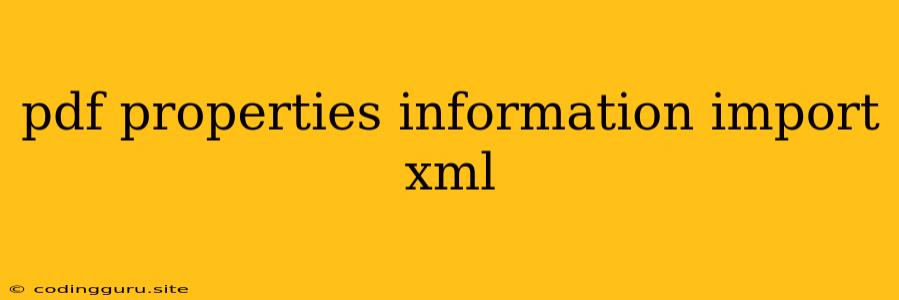Extracting Information from PDF Files: A Comprehensive Guide to Importing Metadata using XML
PDFs are ubiquitous, storing everything from research papers and financial reports to product manuals and digital books. But extracting valuable information directly from a PDF can be a challenge. Luckily, a powerful solution exists: importing PDF properties as XML. This method opens up a world of possibilities for analyzing, processing, and leveraging the metadata within your PDFs.
What are PDF Properties?
PDF properties, also known as metadata, are hidden information associated with a PDF file. This information provides valuable context and details about the document, including:
- Author: The creator of the PDF.
- Title: The document's main title.
- Subject: A brief description of the document's content.
- Keywords: Words or phrases associated with the document.
- Creation Date: The date the PDF was created.
- Modification Date: The date the PDF was last modified.
Why Import PDF Properties as XML?
Importing PDF properties as XML offers several benefits:
- Structured Data: XML provides a standardized format for organizing and storing data. This makes it easy to parse, process, and analyze the information within a PDF.
- Flexibility: XML allows you to define your own data structures, ensuring that the imported information fits your specific needs and applications.
- Interoperability: XML is universally recognized, ensuring compatibility with a wide range of software and systems.
- Automation: You can automate the process of extracting and importing PDF properties, saving time and resources.
How to Import PDF Properties as XML
The process of importing PDF properties into XML involves using specialized software or libraries that can read and parse the metadata within PDF files. Here's a general workflow:
-
Select a Tool: Choose a suitable tool or library that can extract PDF properties and export them as XML. Popular options include:
- Python Libraries: Libraries like
PyPDF2orpdfminer.sixcan extract metadata from PDFs. - Java Libraries: Apache PDFBox or iText offer robust PDF manipulation capabilities.
- Online Tools: Several online services allow you to upload your PDFs and retrieve metadata in XML format.
- Python Libraries: Libraries like
-
Extract PDF Properties: Use your chosen tool to extract the desired properties from the PDF file.
-
Create XML Structure: Define your XML structure based on the extracted PDF properties. This involves creating elements and attributes to represent the data in a structured way.
-
Export to XML: Save the extracted PDF properties in XML format using the chosen tool or library.
Example using Python
Here's a simplified example demonstrating how to extract PDF properties and export them as XML using Python's PyPDF2 library:
import PyPDF2
import xml.etree.ElementTree as ET
def extract_pdf_properties(pdf_file):
"""
Extracts PDF properties and returns them as an XML string.
"""
with open(pdf_file, 'rb') as file:
pdf_reader = PyPDF2.PdfReader(file)
# Create the root XML element
root = ET.Element("pdf_metadata")
# Extract properties
properties = {
"author": pdf_reader.document_info.get('/Author', ''),
"title": pdf_reader.document_info.get('/Title', ''),
"subject": pdf_reader.document_info.get('/Subject', ''),
"keywords": pdf_reader.document_info.get('/Keywords', ''),
"creation_date": pdf_reader.document_info.get('/CreationDate', ''),
"modification_date": pdf_reader.document_info.get('/ModDate', ''),
}
# Add properties to the XML tree
for key, value in properties.items():
property_element = ET.SubElement(root, key)
property_element.text = value
# Convert XML tree to string
xml_string = ET.tostring(root, encoding='unicode')
return xml_string
# Example usage
pdf_file = "your_pdf_file.pdf"
xml_data = extract_pdf_properties(pdf_file)
# Save the XML data to a file
with open("pdf_metadata.xml", 'w') as xml_file:
xml_file.write(xml_data)
Tips for Success:
- Identify Required Properties: Determine the specific PDF properties you need for your analysis or application.
- Handle Missing Data: Not all PDFs contain all metadata. Implement error handling to manage missing properties.
- Optimize for Performance: For large datasets of PDFs, consider optimizing your extraction and XML generation processes for efficiency.
- Validate XML: After importing, use XML validation tools to ensure the integrity and correctness of the generated XML data.
Applications of Imported PDF Properties
Importing PDF properties as XML unlocks various applications:
- Document Management: Organize, categorize, and search PDFs based on metadata.
- Data Analysis: Extract valuable insights from PDF metadata for research, business intelligence, and reporting.
- Workflow Automation: Automate tasks based on PDF properties, like sending documents to different destinations.
- Digital Preservation: Store metadata alongside PDF files for long-term preservation.
Conclusion
Importing PDF properties as XML provides a powerful mechanism for accessing and leveraging the hidden information within your PDF files. This method offers numerous advantages, including structured data, flexibility, interoperability, and automation. By extracting and utilizing this valuable metadata, you can unlock a new level of control and analysis over your PDF documents.
